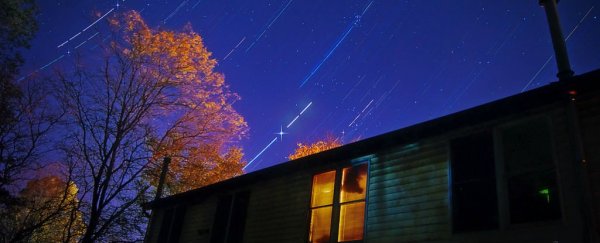Your star-gazing calendar for October is in, and it's going to be a good month.
Right now, Earth is passing through the tail of debris left behind by three different comets, which sounds scary, but is actually awesome, because it brings us the spectacular Draconid meteor shower, peaking on October 7 and 8.
During the 2011 Draconid shower, up to 1,000 meteors per hour were visible in the sky, so it's going to be pretty special. Viewing is bets in the northern hemisphere from just after sunset to midnight.
But even if you're not in the right place at the right time (or it's raining where you are) you can watch the whole thing live on Slooh.
The tail of Halley's comet
That's not all though, because thanks to the tail of Halley's comet, we're experiencing the Orionid meteor shower from now, all the way up until November 7.
The shower will hit its peak on the morning of October 21, when you can expect to see up to 20 meteors an hour burning up in Earth's atmosphere - but due to a bright Moon during that time, your best chance to see the show is at pre-dawn, from now until October 15, according to Earth Sky.
Each year, Earth passes through the tail of Halley's Comet twice - back in May we travelled through the debris, causing the Eta Aquarids shower.
To see some meteors this month, you need to get up early and head out before the Sun rises.
As the name suggests, the meteors will look like they're originating from the Orion constellation in our night sky, but you should be able to see them no matter where you're looking - just keep your eyes peeled, and make sure you find somewhere dark about 20 minutes before you start watching the skies, so your eyes can adjust.
If that's not enough, the Taurid meteor shower will also be visible between October 30 and November 30, with peak activity on November 12.
Check out a nebula in the night sky
If meteor showers aren't exciting enough for you, don't worry, there's plenty of other cool stuff happening in October. For those in the southern hemisphere, you'll even have the chance to see a nebula - the birthplace of stars - with your own eyes.
Throughout this month, the Tarantula Nebula (pictured below) will be visible right near the Large and Small Magellanic clouds (LMC) - the biggest and brightest neighbouring galaxies visible from the southern hemisphere.
"To find them, face due south, and let your eye travel up from the Southern Cross towards the only bright star high above the south (Achernar), you'll see a brightish patch of light," explains Ian Musgrave for ABC Science. "Just below that you will see a bigger brightish patch."
That bottom bright patch is the Tarantula Nebula, and it'll be visible to the naked eye - although if you grab a pair of binoculars, you should be to see a few stars embedded in the nebula, rather than just a blur.
"Better still, if you head out away from city lights with a telescope, you'll see many twisty veins of brightness snaking through it (hence the name 'tarantula', as the strands of brightness looks like the legs of a spider) and a wealth of small star clusters," writes Musgrave.
See five planets in the night sky
But don't despair if you're not in the southern hemisphere, because all across the planet this month, you'll have the chance to see Venus, Saturn, and Mars appearing bright in the western sky just after sunset.
Pay particular attention on October 28, when Venus will appear to line up next to Saturn.
If you're in the northern hemisphere, you'll also have the chance to see Mercury - the Solar System's smallest planet, and the only one other than Earth we suspect to be tectonically active - appearing in the east before dawn.
Mercury will be best viewed during the second week of October, when Jupiter will rise up to meet it around October 11, according to EarthSky.
And the good news is the two planets will be best viewed only shortly before sunrise, so you don't have to wake up too early.
Witness the rare zodiacal light
The name might sound a little astrological, but the zodiacal light is a real astronomical phenomenon, also known as false dawn.
This can only be seen far from city lights, in places you can already see the Milky Way in the night sky (which rules us here in Sydney out). But for all of you that have glorious views of the night sky, you're in for something special.
Just before sunrise in the east, you should see an eerie light on the horizon.
"The light looks like a hazy pyramid of light extending up from the eastern horizon, shortly before morning twilight begins," explains Earth Sky.
It can be seen all over the planet in either September or October, or March or April, and the phenomenon is caused by the reflection of sunlight off cosmic dust between the planets as the Earth orbits the Sun.
"Amazing to think that today we're peering at billions of dust-sized particles that were left behind after the planets formed about five billion years ago," writes Andrew Fazekas for National Geographic.
So no matter where you are in the world this month, or what equipment you've got, be sure to watch the skies, because space has some pretty extraordinary stuff in store. Fingers crossed for clear weather.

